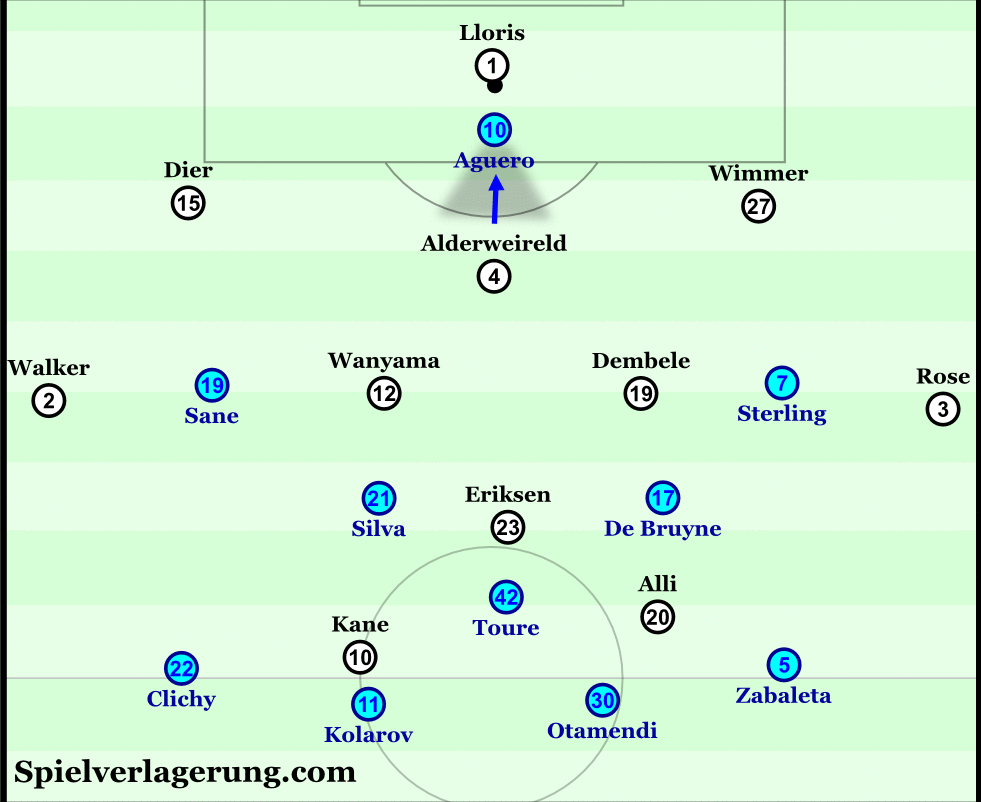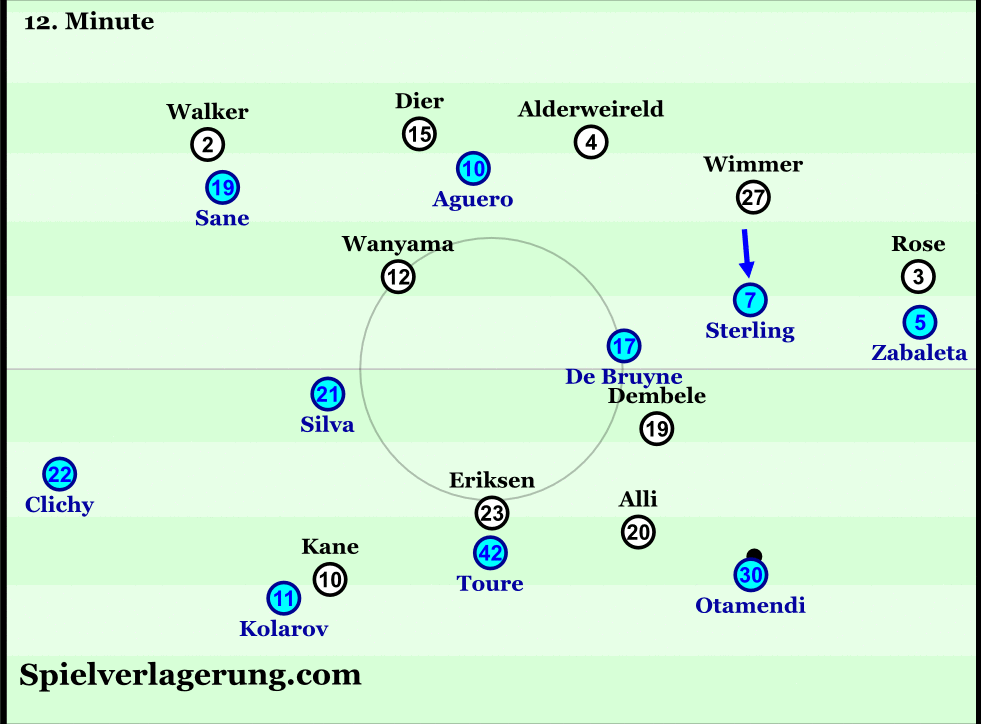City dominate with intense pressing
Guardiola’s Manchester City hosted in-form Tottenham in a highly anticipated clash on Saturday evening. Fresh from their 4-0 defeat at Everton City were under pressure to win to keep alive their increasingly slim title hopes. This task was made tougher since they welcomed the league’s most in-form side with the North Londoners enjoying a 6 game winning streak.
City’s intense pressing out of 4-1-4-1
Perhaps the most impressive aspect of City’s performance was their intensity in high pressing actions. Starting from a base 4-1-4-1 shape City were able to prevent Spurs progressing from deep with a combination of sprints, man-orientations and accurate shifting movements.
From the front Aguero would press either the central defender (Alderweireld) or Lloris depending on who the phase started with. With his pressing run and use of his cover shadow he prevented direct passes into midfield and directed the pass into a wider area. After the pass went beyond him, Aguero’s positioning had interesting effects. From his position behind the Spurs defence (particularly if he pressed Lloris) he could prevent Spurs from re-circulating the ball across by anticipating any passes back to the French keeper. Furthermore the distance between Aguero and Alderweireld was small enough to ensure he could prevent any passes to the Belgian by threatening with aggressive backwards pressing.
When one of Spurs’ side backs received the ball City’s ball-near wide man would sprint out towards them again using their cover shadows to prevent easy passes into midfield. The timing of these runs were crucial, if made too late they would be easily sidestepped and their efforts would be wasted. However, by timing these runs in line with the pass being played they could reach the Dier or Wimmer almost immediately after they received the ball and their proximity gave them the ability to cover a wider distance.
City’s ball-near midfielder would cover any dropping movements with a man-oriented coverage and their close proximity was often enough to prevent passes into the likes of Dembele with the threat of immediate tackles or even interceptions. If Spurs passed from side back to wing-back, City’s ball-near full-back would rush forward to engage them and often ensured that the advantages built up through the last few actions were not lost. With Rose or Walker receiving passes on the touchline from players only metres behind them, they at times received the ball facing their own goal, and City’s full-backs aimed to prevent them turning.
These pressing movements were supported by effective layering in deeper positions. The ball-near central midfielder (De Bruyne or Silva) would move slightly deeper and assist Toure in covering the space in front of the defence. At times the Ivorian was required to drop into the defensive line to cover for advancing full-backs.
The away side experienced large difficulty in coping with this pressure and their build-up was severely disrupted leading to low stability in the game and several turnovers inside their half thus giving Guardiola’s side numerous opportunities in transitional attacks. However the home side squandered several of these opportunities blighted at times by indecision, poor decision making and at times inaccurate finishing.
City’s diagonal attacks
One key feature of City’s attacking game was diagonal entries into attacking areas and moving to attack Spurs’ backline directly from there. At times this was done through vertical passes into one of the forwards who would then turn their opponent and dribble diagonally towards Spurs’ backline. On other occasions City were able to set up these attacks after beating Spurs’ pressing with diagonal passes into one of the forwards.
Sane and Sterling in particular at times used intelligent double movements to get free in the half spaces. On other occasions the distances between them and their direct Spurs opponents (Dier and Wimmer) meant they had small time frames to receive the ball free from pressure. They could then use the Spurs defenders’ pressing momentum against them to turn.
The key to these attacks were effective balancing movements from the likes of Aguero and De Bruyne. By moving from the centre or half space to the flank they could open space for the ball carrier to dribble diagonally into the centre. Alternately their runs into depth could offer through ball options if Spurs did not track their movement.
In line with this City’s ball-far winger, Aguero and at times De Bruyne would offer runs in behind either giving the ball carrier more time to take the ball forward or giving options to break through Spurs’ last line of defence.
Spurs switch to back 4
Pochettino’s side had issues in trying to retain offensive presence for counter attacks and higher pressing whilst covering the half spaces in front of their defence. At times when transitioning from higher pressing in their base 5-2-1-2 shape to defending in their own half they struggled to defend the large spaces to either side of the midfield pair.
After around 20 minutes of the first half Pochettino switched to a 4-3-1-2, the individual positioning was still shuffled as Eriksen started as a number 10 before moving to the right of the midfield 3 and Dembele moving behind Alli and Eriksen. The intention behind the switch was not clear, however Spurs began to establish more stability in their game.
Through Alli or at times the full-backs the London outfit won a number of set-pieces through counter attacks which they indirectly used to maintain possession within City’s half. This allowed them to use their presence in central areas to combine, narrowing City’s defensive shape and creating space for Rose and Walker on the flanks in the process.
They were still largely unable to progress cleanly when attempting to build from deep in their own half and City’s pressing still forced turnovers, however Spurs now faced these situations less regularly than in the opening exchanges.
Pochettino modifies player roles
After the interval Son came on in place of Wimmer as Spurs moved to a 4-2-3-1 that acted in a 4-2-2-2 shape against the ball. With this formative change came an adaptation of the player roles. Son acted as a last line roamer who gave depth with diagonal runs from the wings. This meant Alli could join Eriksen in giving the away side a strong presence behind City’s midfield line to improve their capacity to develop attacks through the centre.
The half continued in a similar manner to the end of the first as Spurs continued to play direct balls to gain territory. Additionally the substitution of Son gave them a better ability to attack the space behind City’s defence. By positioning themselves effectively for 2nd balls Tottenham could either start attacks in City’s half or create opportunities to press City deep into their half if the long balls were inaccurate.

Whilst Eriksen and Dembele seemed to have swapped in this scene, it was a good example of the new structure.
Whilst Spurs were gradually gaining a foothold in the game City were now increasingly able to create dangerous opportunities on the counter attack. Two of these situations led to City’s goals and a number of other wasted opportunities. Part of the issue for the London side was that their direct nature meant the midfielders were not given enough time to get into adequate positions to defend transitions. Wanyama and Dembele were at times tasked with defending the counters in midfield whilst the front four attacked. This was predictably insufficient to protect the width of both half spaces and was thus a part of Spurs’ inability to control these situations.
the counter attack. Two of these situations led to City’s goals and a number of other wasted opportunities. Part of the issue for the London side was that their direct nature meant the midfielders were not given enough time to get into adequate positions to defend transitions. Wanyama and Dembele were at times tasked with defending the counters in midfield whilst the front four attacked. This was predictably insufficient to protect the width of both half spaces and was thus a part of Spurs’ inability to control these situations.
The flow of the game had changed and City’s two goal lead served to enhance this. Tottenham benefitted from their increased offensive presence to create dynamic combinations whilst creating space in wider areas for the full-backs. The adapted player roles had an effect in both of the away side’s goals with Eriksen and Alli connecting attacks in advanced areas before a direct involvement in the goals.
Guardiola’s side were still able to create some dangerous situations partly through the away team’s inability to control the half spaces in front of their defence. In their 4-2-2-2 shape the 2 wide players did not prioritise defending the space on their inside strongly enough and the likes of De Bruyne and Silva were able to receive in these gaps besides Tottenham’s midfield pair.
Conclusion
Guardiola’s men put in a vastly improved performance and were able to dominate one of the league’s strongest outfits with their aggressive pressing. Unfortunately their luck in front of goal was not much better and they squandered several opportunities which was behind their inability to close out the victory. Pochettino will be pleased with his side’s reaction to come from behind and the way he adapted the roles of his attackers increased their attacking threat immensely.


Keine Kommentare vorhanden Alle anzeigen